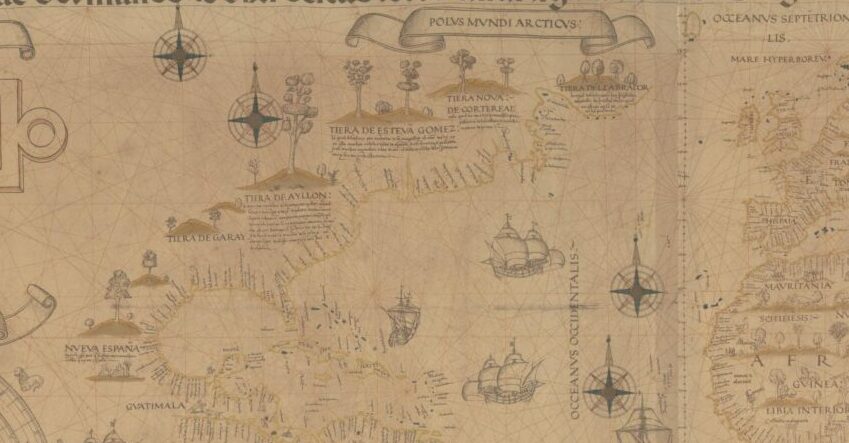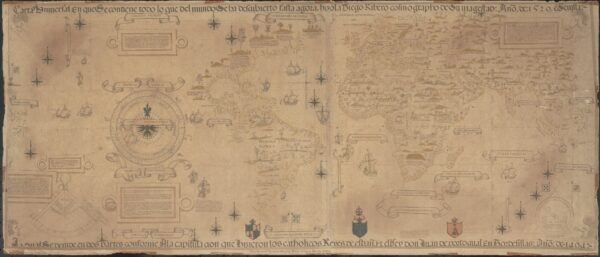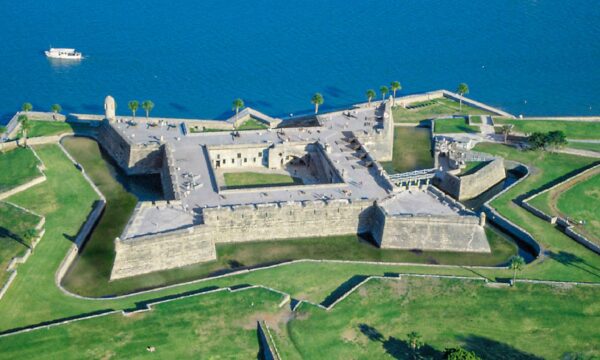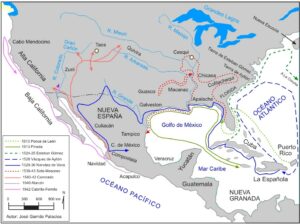Text adapted from the magazine The Hispanic Roots of the United States published by of Asociación Cultural Héroes de Cavite. The magazine is free to download and we encourage you to read it and share it!
The saga of early Spanish exploration in the US is a captivating chapter in the history of the Americas. Juan Ponce de León, pivotal in the conquest of Puerto Rico in 1508, embarked on a groundbreaking journey in 1513, exploring the east and southwest coasts of the Florida peninsula. This voyage resulted in the first known reference to the Gulf Stream, crucial for navigation from America to the Iberian Peninsula, thus playing a key role in America – Europe travels.
In 1519, Alonso Álvarez de Pineda’s exploration of the North American coast of the Gulf of Mexico furthered the cartographic knowledge of the era. His journey through the modern-day states of Florida, Alabama, Mississippi, and Texas, and the discovery of the Mississippi River’s mouth, yielded the oldest known map of this region, a cornerstone in the history of exploration of the US gulf coastline.
1521 was marked by a poignant episode in Early Spanish Exploration in the US when Ponce de León’s attempt to establish a settlement in Florida led to his untimely death. Concurrently, Lucas Vázquez de Ayllón ventured along the Atlantic Ocean coasts from 1520 to 1526, reaching North Carolina and Virginia. His founding of San Miguel de Guadalupe in 1526, though ephemeral and of debated location, marked an early attempt at Spanish settlement in what would become the United States.
Esteban Gómez’s 1524-1525 exploration of the Atlantic coast from the Labrador Peninsula to the Florida Peninsula, entering the Hudson River and what is now New York Harbor, was a pivotal moment. His journey led to the northern half of the U.S. coast being named “Tierra de Esteban Gómez” on maps for a significant period, further emphasizing the impact of Spanish exploration.
The ill-fated 1527 expedition led by Pánfilo de Narváez near Tampa Bay is a testament to the challenges faced during Early Spanish Exploration in the US. Severe hurricanes, native attacks, diseases, and starvation led to its tragic end, with only five survivors. This journey underscores the harsh realities and perils of early exploration. Similarly, Tristán de Luna y Arellano’s 1559 attempt to colonize northwest Florida in the Pensacola area faced similar challenges and ultimately failed.
Pedro Menéndez de Avilés’ successful establishment of St. Augustine on Florida‘s east coast in 1565 (42 years before the English established Jamestown) stands as a landmark event in Early US. This city holds the distinction of being the first continuously inhabited European-founded city in the United States. In 1566, Menéndez de Avilés also founded Santa Elena on present-day Parris Island, South Carolina, marking the beginning of Spanish influence in the region and serving as Florida’s initial capital and a strategic operational base for the Spanish in the north.
The late 16th and early 17th centuries witnessed continued Spanish exploration and mapping efforts in the Gulf of Mexico region, from the Rio Grande to Florida. Captain Alonso de León the Younger’s expeditions between 1686 and 1689 were crucial in mapping this territory, contributing significantly to our understanding of Spanish Exploration in the US.
These expeditions not only charted new territories but also laid the groundwork for subsequent explorations and settlements. They opened avenues for cultural exchanges and set the stage for the complex history of colonization in North America. The efforts of these early Spanish explorers, often fraught with danger and uncertainty, paved the way for the rich tapestry of cultures that form the United States today.
The impact of these explorations went beyond mere discovery. They were the first encounters between the European and Native American cultures, leading to a profound and lasting influence on the language, religion, architecture, and culture of the regions explored. The Spanish brought with them not only their language and culture but also new agricultural practices, animals, and technologies that would forever change the landscape of the New World.
Moreover, these explorations paved the way for future Spanish settlements and missions, which played a significant role in the development of the American Southwest. The establishment of missions, forts, and towns by the Spanish laid the foundation for cities such as San Antonio, Santa Fe, and San Diego, each with its own rich history rooted in these early explorations.
As we reflect on the Early Spanish Exploration in the US, we recognize the bravery and resilience of these explorers who ventured into unknown territories. Their contributions to the mapping and understanding of the New World are invaluable and have left an indelible mark on the history of the United States.
Share this article
On This Day
- 1552 Battle of Bicocca.
- 1565 Miguel López de Legazpi founds Cebu as Villa de San Miguel.
- 1806 María Cristina de Borbón Dos Sicilias was born.
History of Spain
26 August 2020
27 January 2021
Communism: Now and Then
23 December 2022
28 July 2021









